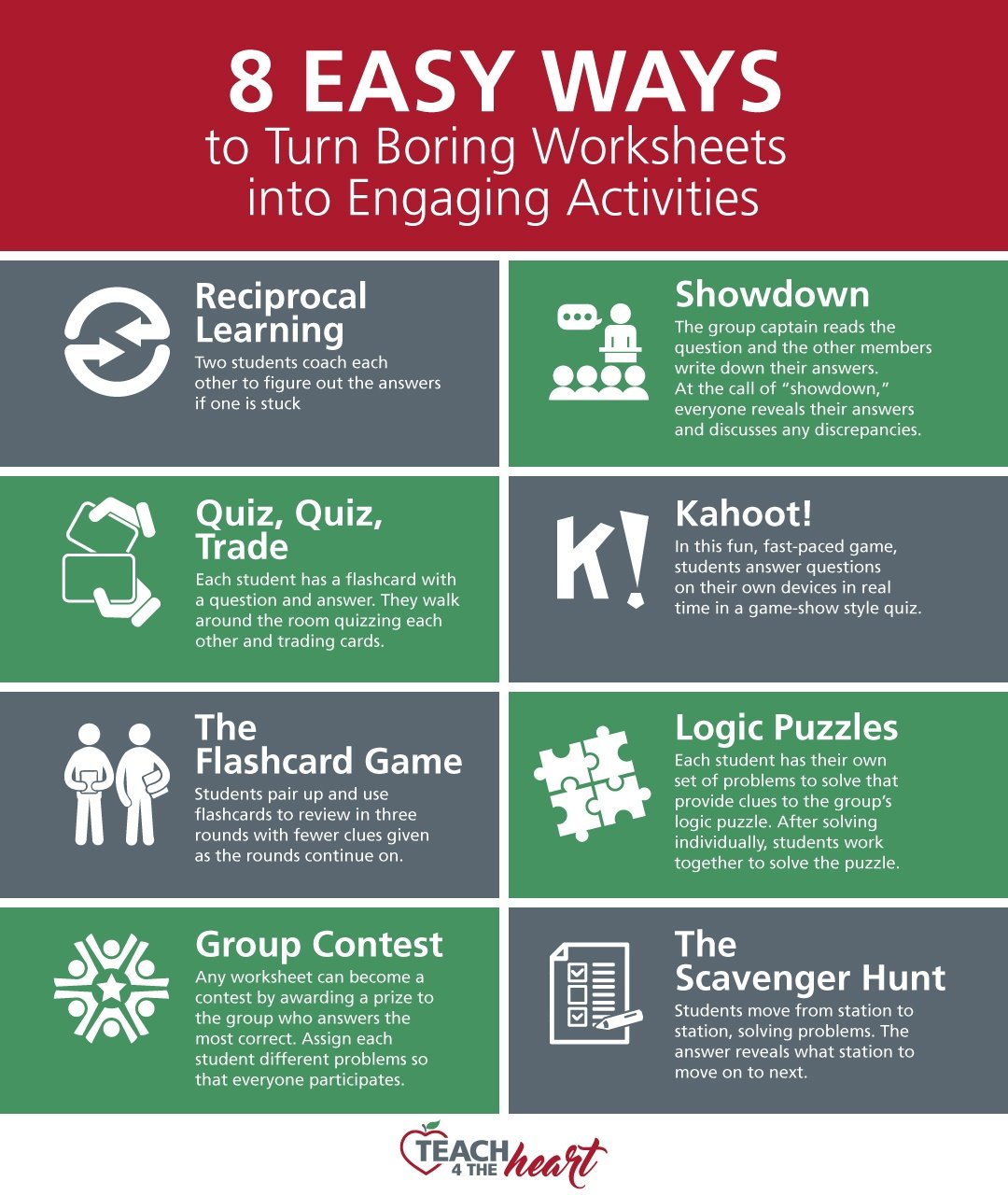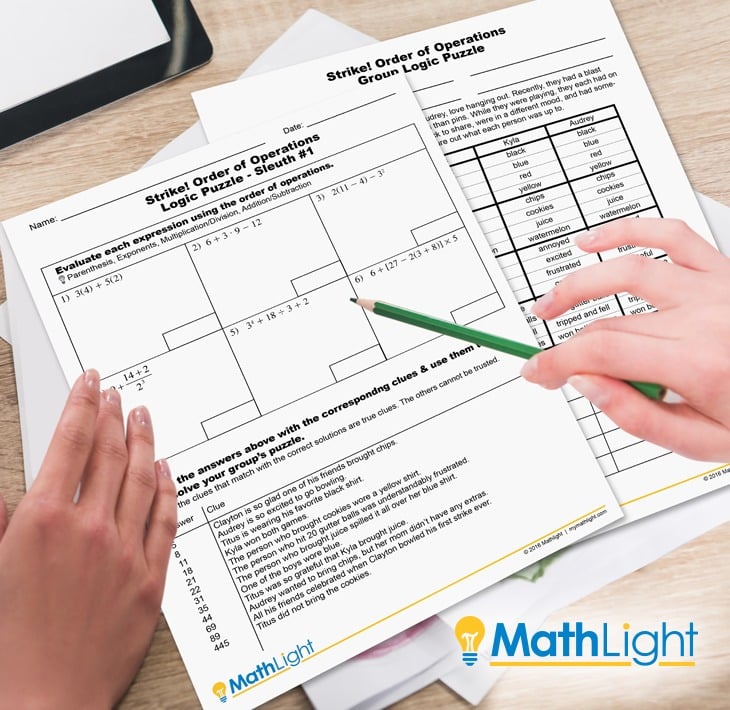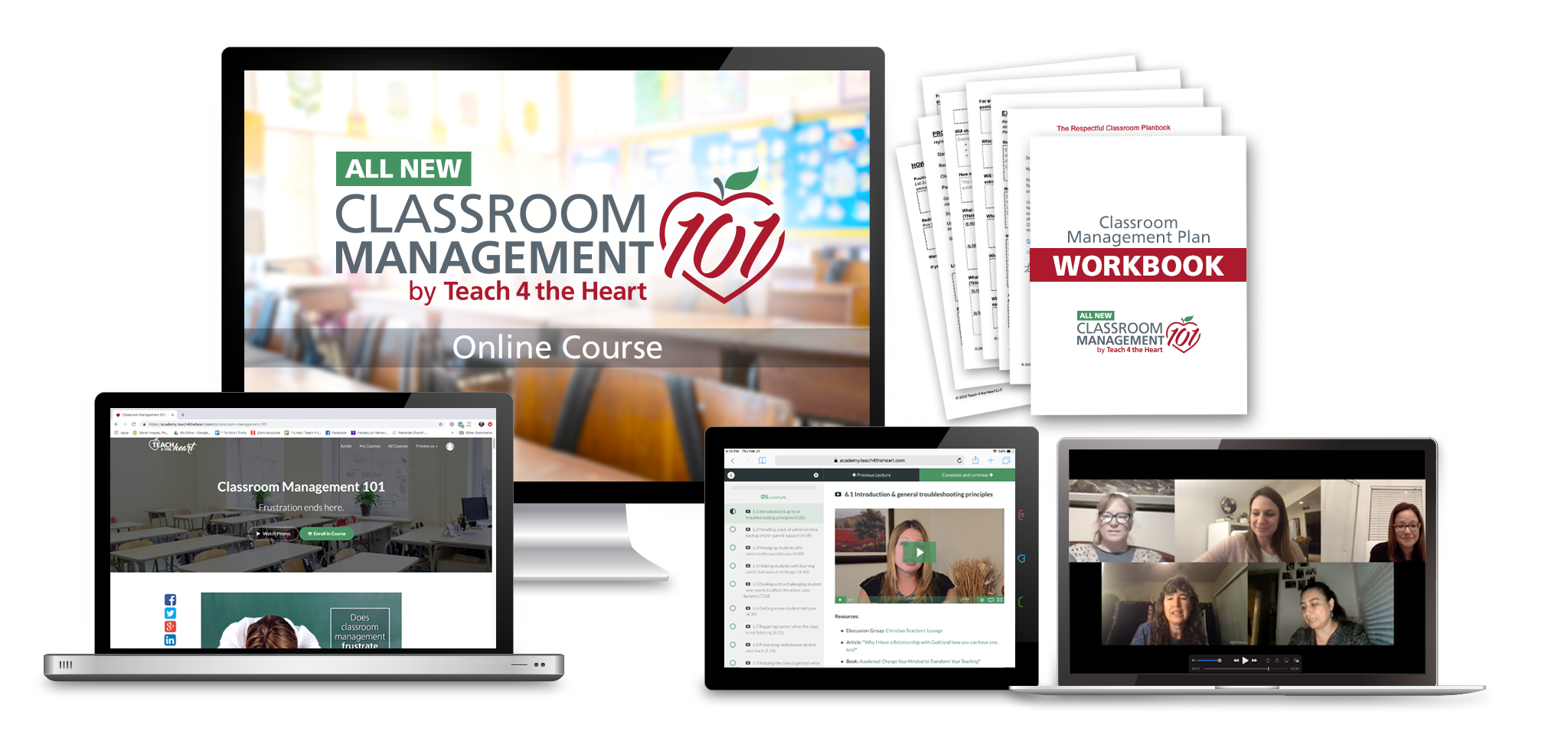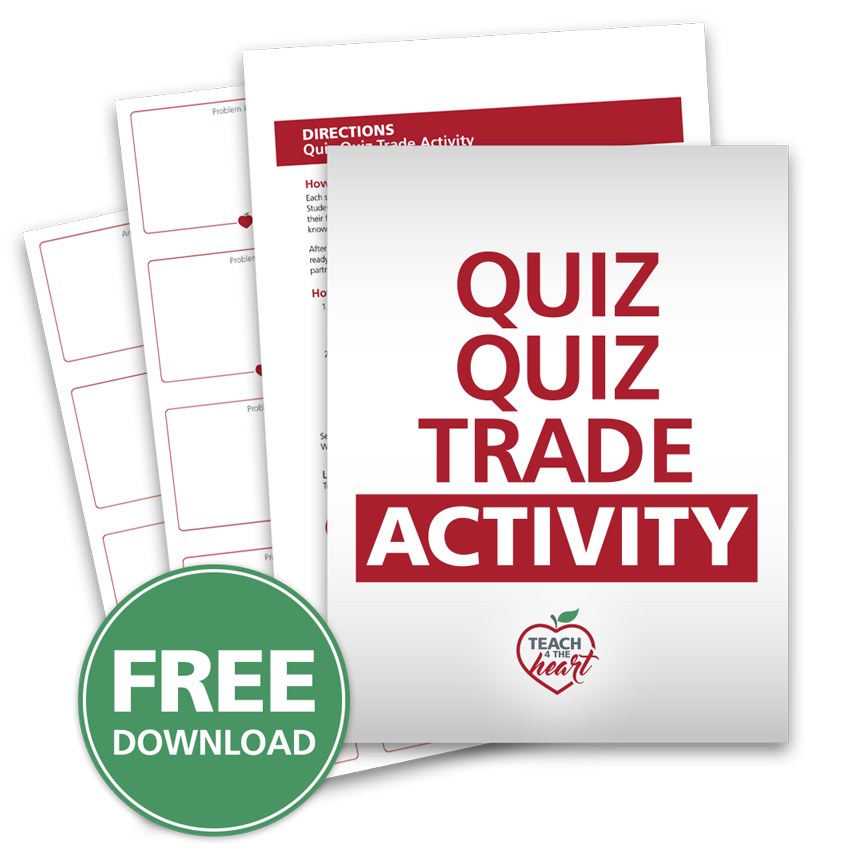
Discover seven easy ways to turn your existing (boring) worksheets into engaging activities that will grab and keep your students' focus.
Are your students tired of doing worksheet after boring worksheet?
What if you could turn worksheets into engaging activities that truly grabbed and kept your students’ focus – without spending tons of time and effort creating them?
Well, that’s exactly what we’re going to do today.
Before we get to that, though, an important note: While worksheets have gotten a bit of a bad rap lately, I do not believe they should be completely taboo.
Meaningful worksheets that help your students practice important skills can still be valuable. So don’t feel guilted into eliminating every single worksheet starting tomorrow. (My friend Jennifer Gonzalez does a great job explaining the difference between "busysheets" and "powersheets" here.)
However, there’s no doubt that the more engaging we can make our learning activities, the more focused our students will be and better they will learn. And these adaptations will help you do just that!
Here's my encouragement: Try out one or two of these activities in the next few weeks. If you like them, gradually incorporate more of them over time and watch your students become more and more engaged.

7 alternatives to boring worksheets
1. Reciprocal Learning
How it works: Students work in pairs and take turns coaching each other. Each student has their own set of problems/questions, and their partner has the answers (i.e. Student A has the answers to Student B’s questions, and Student B has the answers to Student A’s questions). Students go back and forth coaching each other, not giving the answer but helping their partner figure it out.
How to set it up: Split your worksheet into two sections. This can be as simple as saying “student A will do the evens and student B will do the odds.” Or, if the worksheet can be easily split down the middle, that works great, too. Next, prepare the answer keys for each partner. An easy way to do this is to print two copies of your answer key and then white out or cover the answers that shouldn’t be on each partner’s key. Print enough copies so that each group has a worksheet for student A, worksheet for student B, answers for student A, and answers for student B. (If you are having students work problems from a book, you can simply write the #’s each student is to solve on the board.)
More details: Get more tips for how to use reciprocal learning here.
2. SHOWDOWN
How it works: In this activity from Kagan Cooperative Learning, students review or practice problems in groups of three or four. One student in each group (designated the Showdown Captain) reads the first question and all students write their answer on their own paper, tablet, or personal whiteboard, without letting anyone else see their answer. When everyone is ready, the Captain says “Showdown” and everyone shows their answers. Students then compare their responses and discuss any discrepancies. After that, the next student in the group assumes the responsibility of Showdown Captain and reads question #2. The process continues until students finish all questions or time has run out.
How to set it up: Set up for Showdown is super easy. Simply choose an existing worksheet or questions from a textbook for students to answer. Then explain the activity to your students and be available to intervene and answer questions as needed. (You can also add an extra bit of fun by having students answer on personal white boards like these.)
More details: Watch the video below to see an example of Showdown in action.
3. quiz, quiz, trade
How it works: Each student starts with a flashcard containing a question on the front and the answer on the back. Students mix and mingle, looking for a partner to quiz. Student A asks Student B the question on their flashcard, then Student B asks student A the question on their flashcard. (If a student doesn't know the answer, their partner helps coach them to it.) After both questions are answered, students trade cards. They then raise their hands to signal they are ready for a new partner. After finding someone else with a raised hand, they pair up with their new partner and repeat the process until time is up.
How to set it up: This activity requires flashcards. You can either make them on your own ahead of time or have students make them in class before starting the activity. To make them yourself, simply cut up an existing worksheet and glue one question to each card. Fill in the answers on the back either by hand or by cutting & pasting the answers from the answer key.
If you don’t have time to make the flashcards yourself, enlist a student to make them for you. Or, have students make their own flash card in class. Provide each student a blank flash card and have them write one question – either from their notes, from the textbook, or from a worksheet you provide. That will become their first card. (Don’t worry if more than one student chooses the same question. It’s not a problem.)
4. Kahoot!
How it works: In this fun, fast-paced game, students answer questions on their own devices in real time in a game-show style quiz. Students love it, and it’s a great way to practice or review. You’ve kinda’ got to see it for it to make sense, so here’s how it works:
Note that students need their own devices (computers, tablets, or smart phones) for this to work. If there aren’t enough devices for everyone, you can have students pair up in teams.
How to set it up: Create an account at kahoot.com. Then, check to see if another teacher has already created a Kahoot! Quiz that you can adapt rather than having to start from scratch. If you do need to create your own, simply type in the questions and answers, and your Kahoot! Quiz will be ready in no time.
5. the flashcard game
How it works: In this activity from Kagan Cooperative Learning, students pair up and use flashcards to review in three rounds. Each pair gets a set of flashcards. For round 1, student A uses the flashcards to quiz student B, giving as many clues as needed for student B to figure out the answer. Then they switch and student B quizzes student A. For round 2, fewer clues are given, and if the student doesn’t know the answer after one or two clues, the card goes back in the deck to try again at the end. Finally, in round 3, no clues are given at all.
How to set it up: This activity requires a set of flashcards for each pair of students, which can take a bit of time to set up. To save time, consider having students create their own sets of flashcards based off of a worksheet, the textbook, or their notes. This is a worthwhile learning activity in itself and works great as a precursor to the flashcard game.
6. logic puzzles
How it works: In this engaging and brain-stimulating activity, students solve problems or answer questions to receive clues to the group’s logic puzzle. Each student in the group has their own set of problems to solve that they provide clues to the group’s logic puzzle. Once all the problems have been solved and all the clues have been revealed, the group works together to solve the logic puzzle.
How to set it up: This one can be pretty complicated to set up on your own, so we’ve created a template for you. All you have to do is plug in your own problems and answers, and you’re good to go! Just click the link below to request it.
Get the Logic Puzzle Activity Template.
(Please note that this logic puzzle is best suited for students in grades 6-10.)

7. group contest
How it works: Add an extra level of engagement to literally any worksheet by making it a group contest where the first group to get all the answers correct (or the most answers correct) wins. The key: assign certain questions to each student. (For example, if the worksheet has 20 questions and your students are working in groups of 4, write on the board:
Student A does #1, 5, 9, 13, and 17
Student B does #2, 6, 10, 14 and 18
Student C does #3, 7, 11, 15 and 19
Student D does #4, 8, 12, 16 and 20
Everyone can help each other as needed, but with this method, each student feels personal responsibility and no one can skate by simply sitting around watching the rest of the group work.
How to set it up: Pretty much no set up needed on this one. Simply divide your class into groups, hand out the worksheet, and write on the board which student does which problems. That’s it!
Bonus Activity: The Scavenger hunt
How it works: This activity incorporates movement and allows students to self-check as they move from station to station, solving problems. The answer to each problem tells them what station to move onto next. Successful students will complete a full station loop by the end.
How to set it up: Set up 10-20 stations around the classroom that each consist of one paper. The bottom half of the paper has one problem on it. The top half of the paper has the answer from another station on it. That's all! This idea comes from Noelle at Maneuvering the Middle and she has more information and pictures on her blog here.
more ideas:
My friend Angela Watson has more easy-to-implement ideas in her article here:
5 Ways to Turn a Worksheet into a Collaborative Critical-Thinking Activity
final tips
Here's some ideas to make these engaging activities take just a bit less work & go a bit more smoothly.
- Always print and save an extra copy of each activity. Then, next year, you can repeat the activity with relatively zero prep.
- Since the questions/answers are based on an existing worksheet or textbook, you can enlist help from students, parents, or aides for the actual busywork of setting up the activity.
- Invest time into explaining and practicing the procedures for each activity. If things aren’t going right, stop and correct them rather than letting things go off the rails.
- Get started right away! Download the free Quiz-Quiz-Trade activity today, and make learning fun and engaging for your students tomorrow!
Want more tips to keep your class on task?
Check out our free class: How to Reduce Disruptions without Yelling, Begging, or Bribing.
NEED Even MORE GREAT IDEAS?
If you found these ideas helpful, consider joining us in the All-New Classroom Management 101 where you'll get step-by-step training on how to write a classroom management plan that will transform your class culture .

spread the word!
Did you find this post helpful? Clue in your fellow teachers by sharing the post directly (just copy the URL) or by clicking one of the buttons to automatically share on social media.
Pin it for later:

This post may contain affiliate links. This means that if you purchase a resource/product after clicking the link, Teach 4 the Heart will receive a small commission at no extra cost to you. Thanks for helping support Teach 4 the Heart in this way.



I love these tips! It’s so easy for worksheets to turn into “busysheets.” I recently created a worksheet for my chemistry class that was essentially the opposite of the traditional way of teaching the topic (balancing redox reactions). Instead of providing students with a list of steps to complete, I provided the students with the correctly answered problem (with all mathematical steps shown) and had my students write out the individual steps. By reversing the roles, my students were forced to problem solve and use critical thinking skills instead of simply memorizing a list of rules or steps. I shared the worksheet on my blog: https://www.yourclassroomhelper.com/home/engaging-math-haters-in-a-chemistry-classroom
Thanks for sharing!
Wow very good
Amazing!
I loved your theam and content. I am a high school teacher and use most of your ideas. Glad to know that I am on a right track. Kudos to your team!
Thank you for your very kind words!
Thank you for your resources. The link to the Logic Puzzle template does not seem to work for me. Is there another place I can find it?
Oh no! Can you email us at linda@teach4theheart.com and we will email it to you?
Your expertise and insights will immensely enrich our teaching practices and provide us with invaluable tools to enhance our classroom experiences. The [specific resources/strategies] you shared are both innovative and practical, offering a refreshing perspective that will undoubtedly benefit our students’ learning journeys.
Your dedication to empowering educators like us is truly commendable. The depth of knowledge and passion you exhibited while imparting these resources has inspired us to approach our teaching with renewed enthusiasm and creativity.
We are genuinely appreciative of your generosity in sharing your expertise and time with us. Your guidance will not only elevate our teaching but also positively impact the lives of the students we have the privilege to educate.